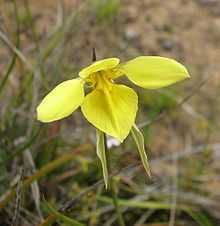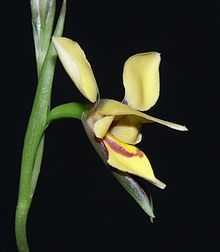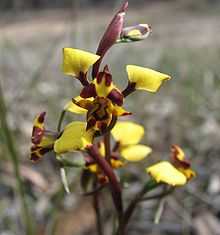Diuris
| Donkey Orchids | |
|---|---|
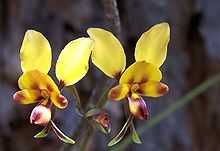 | |
| Diuris magnifica | |
| Scientific classification | |
| Kingdom: | Plantae |
| (unranked): | Angiosperms |
| (unranked): | Monocots |
| Order: | Asparagales |
| Family: | Orchidaceae |
| Subfamily: | Orchidoideae |
| Tribe: | Diurideae |
| Subtribe: | Diuridinae |
| Genus: | Diuris Sm., 1798 |
| Species | |
|
See text. | |
Diuris is a genus of herbaceous plant belonging to the orchid family (Orchidaceae), with more than fifty described species. The genus is presently being revised, with many newly described species.
The scientific name is derived from the Greek words dis (double) and oura (tail), referring to the two lateral drooping sepals, giving a tailed appearance. The common name Donkey Orchid is logically derived from the appearance of the two lateral petals, protruding from the top of the flower like the two ears of a donkey. These features give Diuris its easily recognizable appearance.
Diuris consists of perennial species native to open habitats in Australia and Tasmania, with the exception of one species endemic to Timor.
Many species are common in Australia. They grow in large clusters, due to the vegetative growth of their tubers. The genus is one of the best known of Australian terrestrial orchids with the purple Diuris (D. punctata) being always popular when exhibited.
The basal, grass-like leaves are medium-sized to large. They grow alternately or whorled. Their margins are entire. The central stem can grow up to 1 m high.
During summer, these terrestrial orchids shrivel and wither above the ground. Their underground tubers then become dormant.
The hermaphroditic flowers grow solitary or in several-flowered loose racemes. They can be most diverse, from small (1 cmà to large (6 cm), fragrant or not. Their 3-merous form is usually very irregular. The flowers may be blotched or lacking spots. Their colors vary from a lemon yellow, or yellow and brown, yellow and purple, yellow and orange, to pink and white, or purple. The two lateral petals are rounded or elongated. The dorsal petal forms a hood over the column. The lip is three-lobed. The two lateral lobes form wings.
The flowering period is between July and November.
Pollination is by native, small bees, lured to flowers mimicking flowers of the pea family (Fabaceae), but syrphiid flies and beetles may pollinate as well. The fruit is a non-fleshy, dehiscent capsule, containing between 30 and 500 minute seeds. These seeds mature in a matter of weeks.
Diuris can be grown in a free draining mixture and are relatively easily grown from seed using in-vitro techniques.
The orchids of Diuris are susceptible to the Diuris virus Y, a positive stranded ssRNA virus from the family Potyviridae
Species
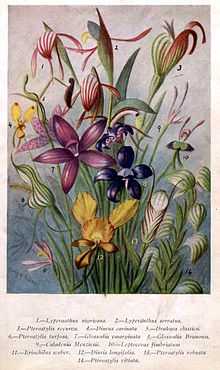

- Diuris abbreviata F.Muell. ex Benth 1873
- Diuris aequalis F.Muell. ex Fitzg., 1876
- Diuris alba R.Br.1810
- Diuris amplissima D.L.Jones 1991
- Diuris arenaria D.L.Jones, 1999
- Diuris aurea Sm. 1804
- Diuris behrii Schltdl. 1847
- Diuris bracteata Fitzg. 1891
- Diuris brevifolia R.S.Rogers 1922
- Diuris brevissima Fitzg. ex Nicholls 1942
- Diuris brumalis D.L.Jones 1991
- Diuris byronensis D.L.Jones 2003
- Diuris callitrophila D.L.Jones 2003
- Diuris magnifica D.L. Jones. ***: PansyOrchid
- Diuris chrysantha D.L.Jones & M.A.Clem. 1987
- Diuris chryseopsis D.L.Jones 1998 : Snake Orchid
- Diuris concinna D.L.Jones 1991
- Diuris conspicillata D.L.Jones 1991
- Diuris corymbosa Lindl. 1840
- Diuris cuneata Fitzg. 1891
- Diuris curvifolia Lindl. 1840
- Diuris disposita D.L.Jones 1991
- Diuris drummondii Lindl. 1840 : Tall Donkey Orchid
- Diuris emarginata R.Br. 1810 : Tall Donkey Orchid
- Diuris emarginata var. emarginata
- Diuris emarginata var. pauciflora (R.Br.) A.S.George 1971
- Diuris exitela D.L.Jones 1991
- Diuris filifolia Lindl. 1840 : Cat's Face Orchid
- Diuris flavescens D.L.Jones 1991
- Diuris fragrantissima D.L.Jones & M.A.Clem. 1989
- Diuris fryana Ridl. in H.O.Forbes 1885
- Diuris heberlei D.L.Jones 1991
- Diuris laevis Fitzg. 1882 : Nannygoat Orchid
- Diuris lanceolata Lindl. 1840
- Diuris laxiflora Lindl. 1840 : Bee Orchid
- Diuris longifolia R.Br. 1810 : Common Donkey Orchid
- Diuris luteola D.L.Jones & B.Gray 1991
- Diuris maculata Sm. 1805
- Diuris magnifica D.L.Jones 1991
- Diuris micrantha D.L.Jones 1991
- Diuris ochroma D.L.Jones 1994
- Diuris oporina D.L.Jones 1991
- Diuris orientis D.L.Jones 1998
- Diuris palustris Lindl. 1840
- Diuris pardina Lindl. 1840
- Diuris parvipetala (Dockrill) D.L.Jones & M.A.Clem. 1987
- Diuris pauciflora R.Br. 1810 synonym of Diuris emarginata var. pauciflora (R.Br.) A.S.George 1971
- Diuris pedunculata R.Br., 1810
- Diuris picta J.Drumm. 1853
- Diuris platichila Fitzg. 1891
- Diuris porrifolia Lindl. 1840 synonym of Diuris corymbosa Lindl. 1840
- Diuris praecox D.L.Jones 1991
- Diuris protena D.L.Jones 2006 : Northern Golden Moths
- Diuris pulchella D.L.Jones 1991
- Diuris punctata Sm. 1804 : Purple Diuris
- Diuris punctata var. punctata
- Diuris punctata var. sulphurea Rupp 1944
- Diuris purdiei Diels 1903 : Purdie's Donkey Orchid
- Diuris recurva D.L.Jones 1991
- Diuris secundiflora Fitzg. 1877
- Diuris semilunulata Messmer in H.M.R.Rupp 1944
- Diuris setacea R.Br. 1910 : Bristly Donkey Orchid
- Diuris striata Rupp 1944
- Diuris sulphurea R.Br. 1810
- Diuris tricolor Fitzg. 1885
- Diuris venosa Rupp 1926
Furthermore there are several species discovered but not named yet.
Natural hybrids
- Diuris × fastidiosa R.S.Rogers 1927 (D. lanceolata × D. palustris)
- Diuris × nebulosa D.L.Jones 1991 (D. aurea × D. punctata)
- Diuris × palachila R.S.Rogers 1907 (D. behrii × D. pardina)
- Diuris × polymorpha Messmer in H.M.R.Rupp, 1944 (D. lanceolata × D. platichila)
References
- Jones, David L. (1970). "Some thoughts on the taxonomy of the genus Diuris". Australasian Native Orchid Society.
